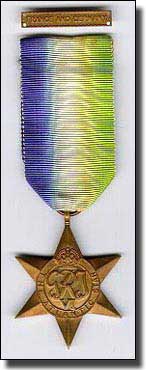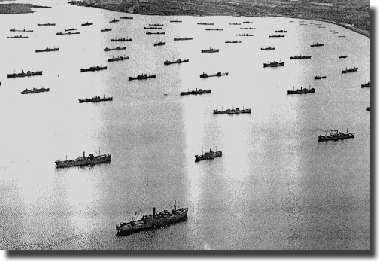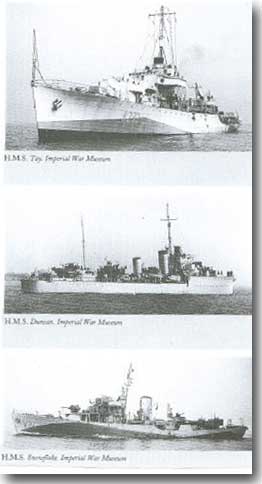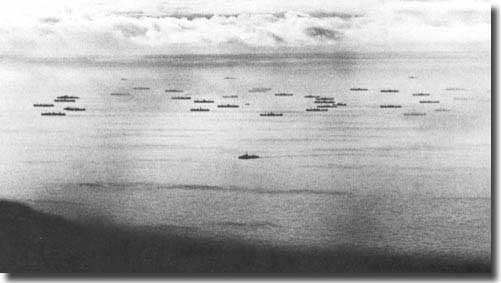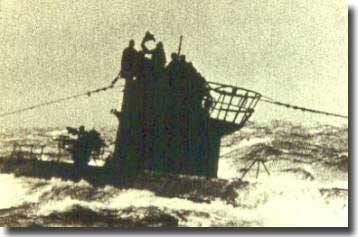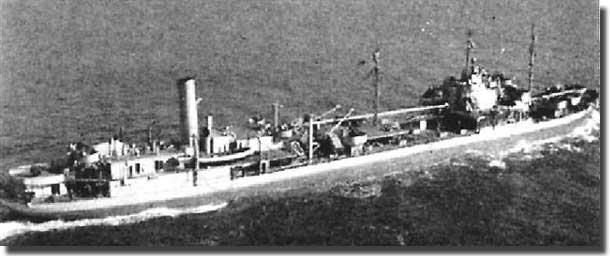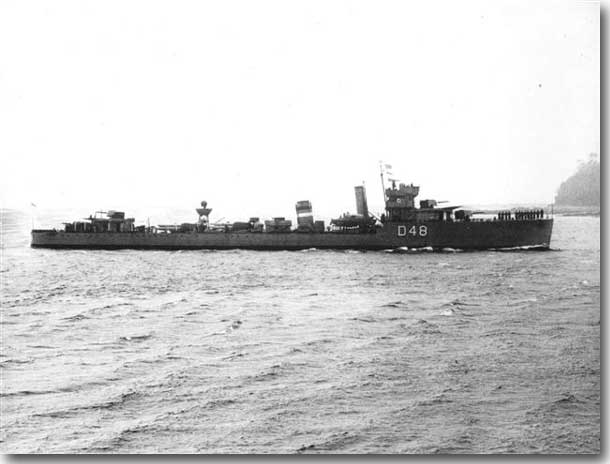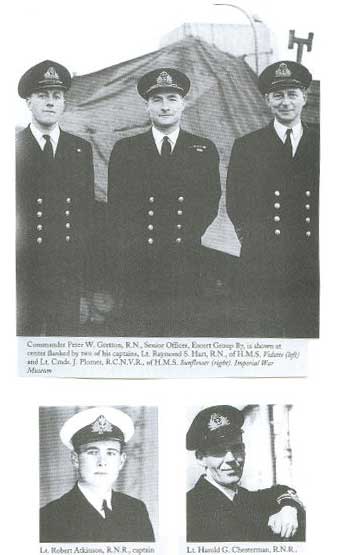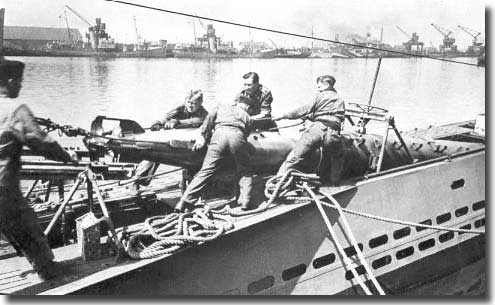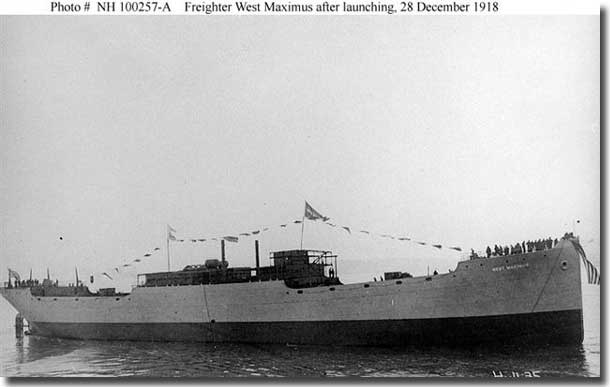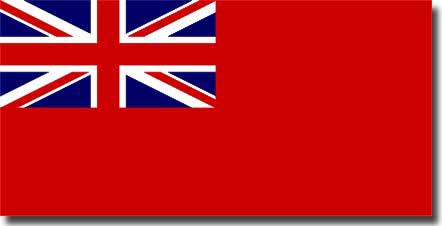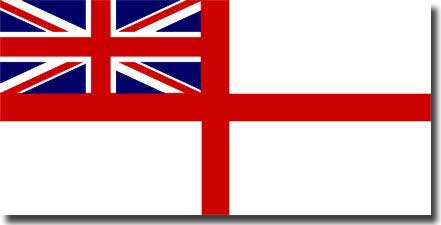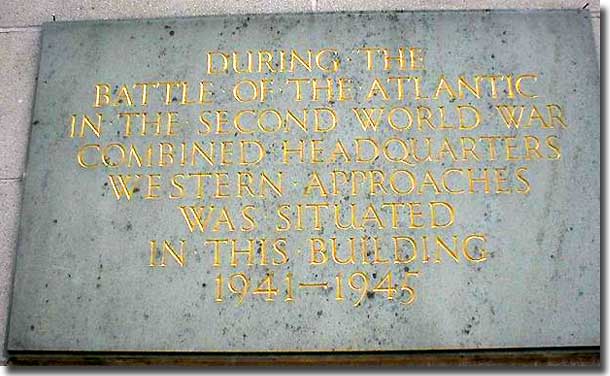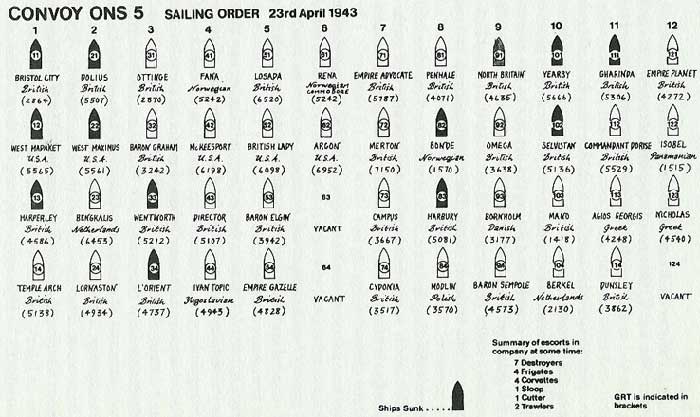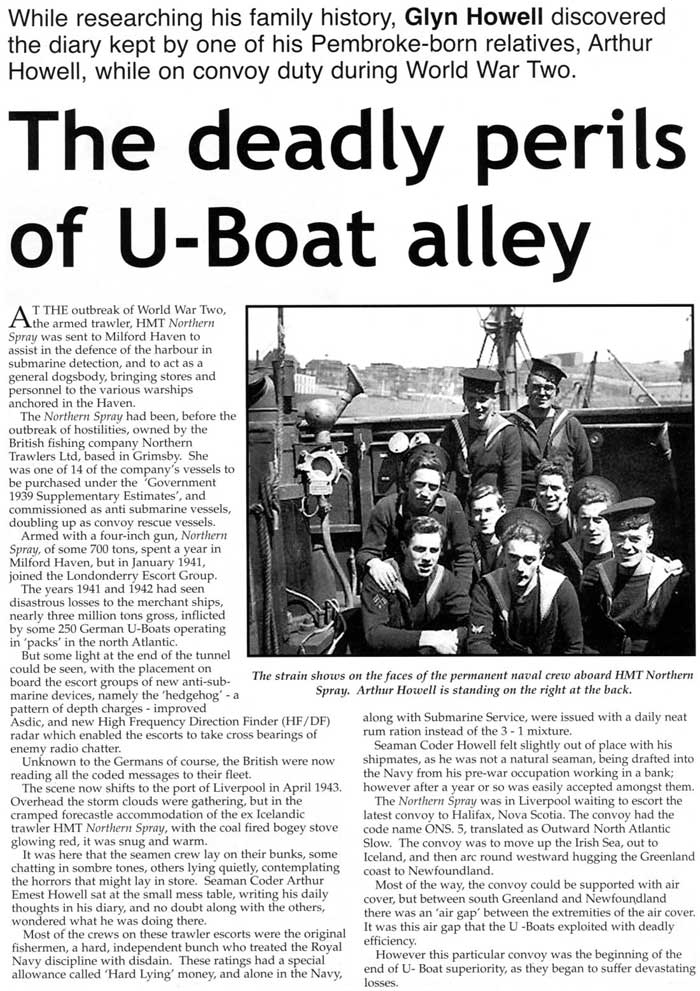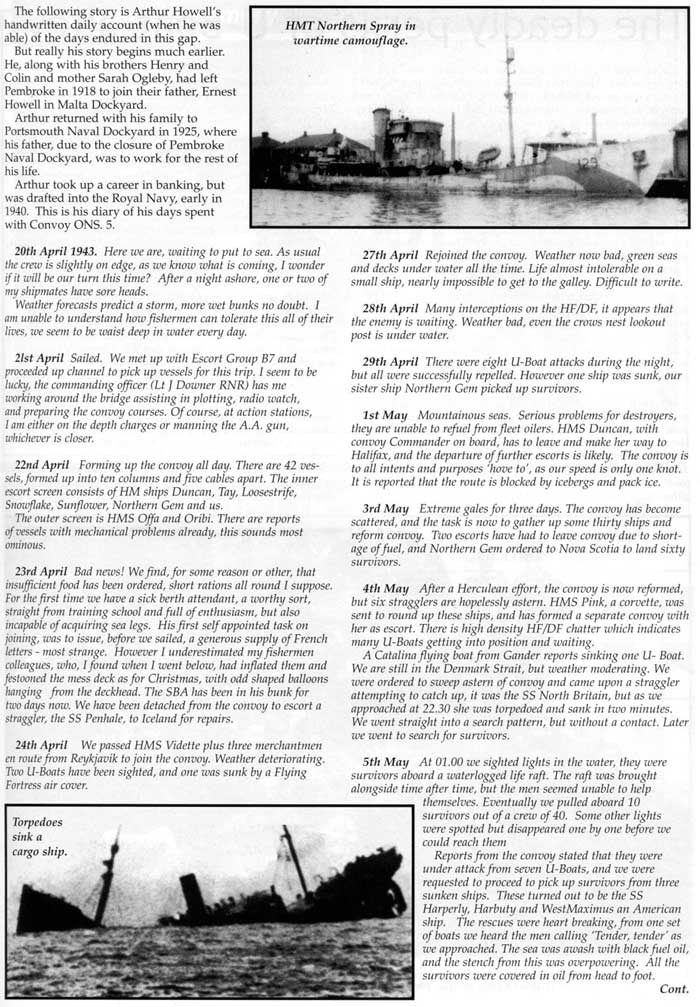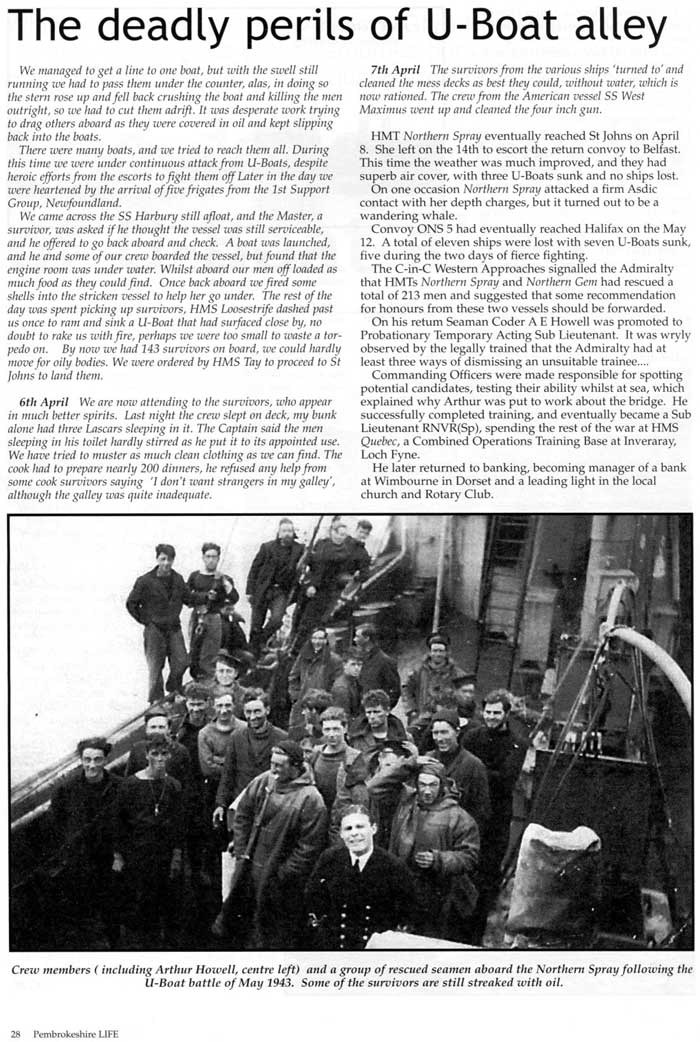|
The Battle For Convoy ONS 5. 26th.April - 6th. May 1943
Atlantic Convoy Instructions.
Convoy ONS 5. The Convoy Commodore was J. Kenneth Brook Royal Navy Reserve, and he formed up his brood, three and four deep over a front of twelve columns. He placed himself at the centre of column six in the Norwegian ship Rena, with the New York bound tanker Argon the one ship astern of him. The majority of the Convoy ships were British, four - McKeesport, West Medaket, West Maximus, and the Argon -were American, Bonde, Rena, and Fana all Norwegian, Berkel and Bengkelis, Dutch, the Greek contingent, Agios Georgios, and Nicolas, Ivan Topia came from Jugoslavia, Isabel from Panama, and finally Bornholm hailed from Denmark.
A convoy assembles during WW2 Two ships, Mckeesport and Dolius ( British ) had initially sailed with Convoy SC 122, and had survived the onslought by U-Boats over the 17th./20th. of March. Most of the Convoy were in ballast, all had sailed before in convoys and knew what was required of them in terms of station keeping, and what they might expect when the U-Boats attacked, as they always did on these journeys across the Atlantic, no matter whether one was East or West bound. The empty ships were bound for both North and South American ports to load food, fuel, armaments, raw materials, for the long flog back to Britain, these convoys were the life line that sustained the English people during the war, and allowed England to build up the sinews of war required for the future invasion of fortress Europe. By the 2nd. of April, the Commodore had assembled his flock, 1,000 yards between columns, and 800 yards between ships in the individual columns. over all this convoy with its Escort was spread over 8.75 nautical miles. Commander Peter Gretton, Royal Navy was the Senior Officer of this B7 Escort Group. The leader's ship was the destroyer HMS Duncan, the 5th. ship to carry that name, launched in July 1932, to be completed by the end of March 1933, and converted to an anti/submarine Escort at Chatham, then to join Western Approaches Escort Group B7 in April of 1943. She was fitted with ahead throwing Hedge Hog, High Frequency/ Direction Finding equipment, and Type 271 Radar. Frigate HMS Tay, Corvettes HMS Loosestrife, HMS Pink, and HMS Snowflake, two Rescue Trawlers, Northern Gem and Northern Spray, plus a Tanker, British Lady, made up the Escort. A second destroyer HMS Vidette, commanded by Lieutenant Raymond S. Hart Royal Navy, had gone ahead to collect two freighters, and a USN Tanker from Iceland, and they were all to rendezvous mid ocean. Hart was the only other Royal Naval Officer in command besides Commander Gretton, all other ship Captains were Reserve Officers from Australia, Canada and New Zealand. Gretton had been the First Lieutenant in HMS Cossack at the Second Battle of Narvic, he had trained as a pilot, and had also completed an anti - submarine course at HMS Osprey ( the anti - submarine training school at Portland in Dorset, where I spent six months in 1946 during my specialist course as a Torpedo Anti - Submarine Officer. )
H.M.S. Tay Commander Gretton had won a Distinguished Service Cross in peace time in Palestine, and went on in WW2 to be awarded three Distinguished Service Orders, later he was to become Vice Admiral Sir Peter Gretton, at this stage he was a well trained, hard driving, and efficient Escort Commander. Gretton had worked up his B7 Group to a high standard at Londonderry, having trained them to use the HF/DF fitted in both Duncan and Tay, to gain a cross bearing of any German U-Boat when transmitting a signal to Germany. He made them all use the ASDIC, and depth charge trainers time after time until these drills were second nature. The tactical table at Derry allowed his key personnel to practice manoeuvres and tactics devised by Captain Roberts at his tactical school at Western Approaches in Liverpool. They trained and trained to be in great shape to take on the wily U-Boat commanders in the crucible of that vital fight that could be won or lost, the Battle of the Atlantic, May of 1943 would decide the final victor in this dirty war against the U-Boats, who would win, the hunters, or those who hunted?
Convoy at sea North Atlantic, WW2 Escort Disposition. It was likely that routing ONS 5 east of Greenland would bring them all into pack ice, and even icebergs. The bad weather would at least force the U-Boats to keep their heads down. As the old saying goes " It is an ill wind etc." Admiral Donitz had a record number of his sea wolves at sea, waiting in the gap below Greenland, this area was beyond the range of covering Allied aircraft. It was highly probable that at least 36 U-Boats were formed up in two operational patrol lines, Meise and Sprecht, waiting in a 500 mile arc east of the Newfoundland coastline. The first week of this convoy voyage went off much as the escort Commander would expect, but the Polish ship Modlin was troubled with engine problems on the first night, she left her 8th. column, staggered off, making for the sanctity of the Clyde. HMS Duncan was renowned for the amount of oil she gobbled up, and Gretton on the 24th. of April tried to top up fuel from the British Lady, the fuel hose being streamed astern, but the poor weather caused both the towing wire and the fuel hose to part. The American tanker Argon, used canvas hoses to refuel, and she could only service ships that came alongside, with the bad Atlantic weather that obtained, with high seas running, such a manoeuvre would be far too dangerous except in flat calm conditions. It seemed that Argon's much needed fuel was going to remain on board the tanker, a simple problem of canvas hoses stopping the escorts from receiving the precious oil she carried. It indicated how the planning involved in setting up a convoy that catered for refueling the escort ships enroute, needed to be so meticulous, right down to the finest detail. The end of U-710. Gretton was thus unaware of its near presence until the evening of the 24th. of April after it was attacked by a Flying Fortress Boeing aircraft of 206 Squadron, based at Benecula in the Hebrides. At 1725 ( 5.25 PM ) one of the crew had sighted a fully surfaced U-Boat 10 miles away, it happened to be a newly commissioned Type VII boat, U-710, out on her very first patrol, with her Captain, Oblt. z.s. Dietrich von Carlowitz new to the Battle of the Atlantic. Instead of crash diving at the first sign of an approaching enemy aircraft, he ordered the boat's AA guns just aft of the conning tower to be manned. Inaccurate gunfire did not deter the Fortress which released a stick of 6 Depth Charges at low level, they straddled the boat at right angles to her course. This new U-Boat was doomed, and the hull sank stern first, Flying Officer Cowley circled his bomber, and dropped a second pattern into the wreckage, counting 25 survivors milling around in the swirling waters below him. Low on fuel as he was at the end of his patrol, he made for Reykjavic. One U-Boat down with more to come.
U-Boat at Sea The 25th. of April. Bornholm collided with Berkel, both ships being damaged, the latter stayed within the convoy, and Bornholm left for Reykjavic on her own, Gretton did not want to part with one of his precious escorts to accompany her. She had been holed in the engine room, some 10 feet above the waterline. The storm was so bad that to all intents and purposes the convoy " hove to."
The 26th. of April.
AO 11 Sapelo, the fleet oiler that joined Convoy ONS 5. Now HMS Vidette reinforced the convoy as the second destroyer, arriving with Bosworth, Gudvor, and the empty USN Tanker, Sapelo. Vidette had a greater range than did Duncan,one of her boilers had been removed and this extra space used as fuel stowage. She was fitted with asdic, Type 271 radar, but not with HF/DF. Gretton in Duncan agonised about her poor fuel performance, and signaled Western Approaches that he may have to leave the convoy to refuel in Greenland unless the bad weather moderated. At last the luck changed, the seas calmed down, and Duncan was able to refuel from British Lady, Vidette, and the corvette Loosestrife were also able to top up their tanks, whilst RAF Hudsons from Greenland maintained patrols overhead.
HMS Vidette No U-boat contact with the convoy. Meise had 30 U-Boats sitting and waiting from 59 degrees 15 minutes North, 32 degrees 36 minutes West, to 56 degrees 45 minutes North, 28 degrees 12 minutes West, with the third line Amsel, with 11 submarines all strung out from 54 degrees 51 minutes North, 32 degrees West, in a tighter line down to 53 degrees 45 minutes North, 29 degrees 35 minutes West. Initially these three lines were established to entrap and maul the westbound Convoy ONS 4, but it had evaded this menace to reach New York safely and intact. Two other convoys on a northern route, SC127 ex Halifax on the 16th. of April, and ON179 out of Liverpool on the same date both eluded these three patrol lines. SC127 was rerouted to a more northerly course after the order to increase Meise was intercepted, but it took 14 hours to decrypt it. A further convoy ex Liverpool, on the 24th. of April, ON180. was trailing ONS5, and it too missed all the waiting U-Boats. With all the U-Boats assigned to northern latitudes two other convoys on their way to UK, HX235, and HX236, whilst at sea, were directed to sail southerly courses, this tactic was also successful. It was a real game of cat and mouse, the giant chess like plotting table at Western Approaches Headquarters in Liverpool, showing all the convoys at sea, enormous lanes of traffic, the German U-Boats positioned by their command BdU, where they believed the convoys would pass, and Western Approaches staff with the benefit of the code breakers craft able to receive and decrypt the U-Boat orders deploying their boats at sea, the British were then able to move their convoys onto courses that should then evade the waiting sea wolves ready to pounce on unsuspecting sheep making up the convoys ploughing the unforgiving waters of the North Atlantic Ocean. Admiral Donitz in command of the U-Boat Division tended to blame the lack of contact of his waiting U-Boat lines to the fact that Allied aircraft carried a Radar device that his Submarines were powerless to intercept. At no time during WW2, or indeed post war would he admit to the fact that the Allied cryptographers had cracked the German Navy Cipher. Nine days of intelligence blackout. ONS5 was in extreme danger, unknown to both Commander Gretton, and Western Approaches Command, was the new move by BdU, on the 24th. of April, Gruppe Star, 16 newly assembled U-Boats, along a north/south line at 30 degrees West between latitudes of 61 degrees 50 minutes and 57 degrees North, about 400 nautical miles of Greenland. These submarines were ordered to be on station by 0900 ( 9 AM ) on the 28th. of April, the northern most arm of this line would just cross the course of convoy ONS5. This group was set up precisely to catch the next oncoming convoy, namely ONS5. About this time, the German radio that listened in to, and could read the Anglo/American Naval Cipher No 3, the one used to route convoys, and these messages also included the Admiralty's and United States Navy daily U-Boat situation Reports, one would have thought these situation Reports would have shouted to the BdU that its own codes had been broken. But no, they did not realise that their Cipher had been compromised. The BdU Situation Room when it received details of a specific convoy, such as its composition, course and speed, gave it a number, for ONS5, it was Number 33.
Officers First sighting of ONS5 by a U-Boat. At 1040 ( 10.40AM ) a second U-Boat surfaced a short distance from U-650, and BdU directed all Star boats to attack, based upon U-650's report. Back at the convoy, Duncan and Tay had picked up this radio transmission on their HF/DF equipment, so Gretton now knew the convoy was being shadowed, but he had no inkling just how many U-Boats, he and his escorts would soon need to repel. Snowflake was ordered to steam down the bearing from the transmitting U-Boat, but they neither found nor heard anything. The convoy was ordered to alter course 35 degrees to starboard until 1600 ( 4PM ) when it again resumed a course of due west. Visibility had now fallen to about 3 miles. At 1838 ( 6.38PM ) as a heavy oncoming sea formed, Duncan's HF/DF picked up a U-Boat bearing 210 degrees, close to her port bow, they chased it at top speed, with Tay making a parallel search. By 1920 ( 7.20PM ) from Duncan's bridge the spray thrown up from a conning tower of a U-Boat was sighted bearing 146 degrees, about 2 miles off. Course was altered to stem the target, but at 3,000 yards range this boat dived and in the rough seas obtaining, the destroyer's Anti-Submarine Detecting equipment failed to make any contact. With a destroyer bouncing up and down , the ASDIC dome housing the sound detection gear, which is located in the keel of the ship just below the bridge level, would also smack in and out of the rough water, this quenching within the dome makes life very difficult for the ASDIC operator to clearly hear any returning ping of the echo bouncing back from the submerged submarine. Using his plotted position of the U-Boat, Gretton unleashed a 10 charge Depth Charge pattern. Duncan and Tay now carried out a two mile sided square search with the Datum or plotted contact as its centre. Tay was left behind to sit on the U-Boat, to keep its head down, and Duncan returned to the convoy to order night stations at 2130 ( 9.30PM ) ONS5 on a south west leg, course 240 degrees, speed 7.5 knots. The sea was rough with a long moderate swell running. Commander Gretton believed any attack would come from the port side, so he placed all his defences there leaving the starboard bow uncovered.
The German Position, and ordered reinforcements for ONS5. The Stage is set. Lieutenant Robert Atkinson RNR, Captain of the corvette Pink, and later to become Sir Robert, recalls that fateful night of the 28th. of April well, it was 1700 ( 5PM ) pitch black, windy as hell, I told the crew, "Hands to tea at six o'clock" and cleared lower deck ( that is mustering all the crew other than those on watch in a specific place on board ) and said. " There's going to be a hell of a battle tonight. I'm not sure how many of us will see daylight. I intend to see it if I can." So it was all up to us. The Western Approaches warning was out by 2 hours, one of the Star boats to port made the first of 6 attempted attacks on the convoy between 2358 ( 11.58 PM ) and dawn on the 29th. On the port bow, Sunflower made a Radar contact at 3,000 yards at 170 degrees, she quickly ran down this bearing and the U-Boat dived, no ASDIC contact was obtained but she dropped 2 depth charges to keep the boat down, then regained her convoy station. At the second attempt to penetrate the screen, at 0045 ( 00.45 AM ) Duncan also picked up a Radar contact at 2,500 yards, and her ASDIC made contact at 1,500 yards, but immediately lost the echo, 1 depth charge was dropped, and the leader was back in station by 0114 ( 1.14 AM. ) Straight away the third attempt was made, yet another Radar contact 2,500 yards away on a 296 degrees bearing. Off Duncan charged again at her best speed until 0019 ( 1.19 AM ) at a range of only 1,100 yards, the U-Boat dived, Duncan reduced speed to allow the ASDIC to be used efficiently. Now a 10 charge pattern of depth charges was unleashed in the submarine's wake. The escorts were making the German boats keep their heads down to the benefit of all in the convoy, now at 0130 ( 1.30 AM ) the 4th. attempt to attack was under way, bearing 146 degrees at 4,800 yards, once more Duncan hot footed after this contact, forcing the boat to dive at 3,000 yards, ASDIC contact was made, and a single charge was dropped on the plotted position. Turning to resume her station, the destroyer picked up yet another Radar contact at 0156 ( 1.56 AM ) at 4,000 yards on a 210 degrees bearing, this the 5th. attempt, this U-Boat was making for the convoy at 12 knots on the surface, at 0204 ( 2.04 AM ) and when as close as 1,500 yards, she dived just as Duncan passed through a circle of oil on the ocean surface, it was 50 yards in diameter, suggesting the boat had been attacked earlier and was damaged. Good ASDIC contact was obtained, and an accurate 10 charge pattern was sent on its way. Duncan passed over the wake, and contact was regained astern, but lost at 800 yards, just as the Hedge Hog weapon was about to be fired. Now it was Snowflake's turn to foil the 6th. attempt mounted from the port beam, at 0339 ( 3.39 AM ) she sighted a U-Boat on the port bow, at 1,100 yards, and she fired two by 10 charge patterns. Now Tay covering the stern, got into the act by attacking a good ASDIC contact to thwart a possible 7th. attack to get through the defences to attack ships in the convoy. By 0416 ( 4.16 AM ) dawn was starting to break, a busy night was had by the escorts, especially by the leader in Duncan, but the convoy had been protected, and remained unscathed. No ships had been lost against a number of U-Boats, who in turn had suffered severe damage to two of them, U-386 and U-528 were forced to withdraw from this fight and return to base. On the 11th. of May, U-386 limped into her home port of St Nazaire, whilst U-528, on the same day, and on her first patrol, was close to entering the Bay of Biscay, when she was sighted and bombed by a Halifax aircraft D, from 58 Squadron, HM Ships Fleetwood and Mignonette, escorts with Convoy OS47, soon finished off this U-Boat, 11 of her crew died, and 45 were captured. Gretton thought that he had achieved a kill on the boat making the third U-Boat attack, in fact he probably caused the damage to one of the two submarines forced to retire. He said: " All in all, a most successful night." Having thwarted all the attacks during the dark hours, Gretton believed the frustrated U-Boat Captains would try their luck during daylight, he was right, and did not have long to wait. U-258 slipped inside and under the convoy lines, taking up a position at periscope depth to starboard of the N0. 4 column, it was now broad daylight, and at 0729 ( 7.29 AM ) she scored a torpedo hit on the US freighter McKeesport, the second ship in Column 4. When the alarm blared, Gretton was catching a quick moment of sleep in his sea cabin, he quickly made his bridge, ordering Operation Artichoke at 0730 ( 7.30 AM )
Loading a torpedo into a German U-Boat The ship in position S ( astern ) closes the torpedoed ship, the ships ahead in position A, and those in positions L on the port bow, and B on the starboard bow, all turn outwards, and steam the reciprocal convoy course at 15 knots, sweeping in line, the wing ships passing outside the convoy wake, the inner ships between the convoy columns until they reach a line 3 miles astern of the position the convoy was in at the time the ship was torpedoed. All other escorts stay with their convoy charges. In another five minutes Commander Gretton noted a torpedo which had passed through several columns of the convoy without a hit, and explode at the end of its run on the port quarter, indicating that the attack had been launched from the starboard side. The rescue trawler Northern Gem, attained an ASDIC contact, and dropped 3 depth charges with a negative result. McKeesport had a hole opened up by the torpedo abreast No.1 hold which was filled with sand as ballast. It quickly filled with inrushing sea water, and the ship lurched off to port, almost running down the British Baron Graham, which took avoiding action. For another 50 minutes the torpedoed freighter maintained her station and the speed of the convoy, but with her engine room now flooding, at 0815 ( 8.15 AM ) she started to sink, and her Master ordered "ABANDON SHIP." There was but one fatality on board, a Swede, John A. Anderson, now Northern Gem came alongside and picked up 43 seamen and 25 naval personnel, she now tried to sink the wreck by gunfire, but without result, Tay was ordered by Gretton to dispose of the sinking ship, which she did by use of depth charges blasting another hole in her hull. No further attacks over the night of 29th./30th. Coastal Command was able to reestablish air contact, when a Liberator flew over ONS5 from Iceland at 0645 ( 6.45 AM ) on the morning of the 30th. But this cover was short lived, visibility soon diminished, and the Once more the wild Atlantic lived up to its awesome reputation, as a full gale struck, by 2100 ( 9. PM ) the height of the waves was causing the escorts "To roll their guts out." But even in the appalling weather some U-Boats had maintained contact with the convoy, a new day had started, and at 0105 ( 1 AM ) Snowflake had found a U-Boat by her radar at 3,000 yards away, she rushed down the bearing firing off a starshell to illuminate the scene, catching the U-Boat in the glare of light only 3,000 yards away. Both her 4 inch deck gun and the 20mm AA Oerlikons loosed off rounds which forced the boat to dive. A depth charge was dropped over the diving swirl of water caused by the crash dive, in rough weather, always an event that the escort does not relish, the hunter needs to quickly put distance between her stern and the forthcoming Depth Charge explosion, no easy task in the teeth of an Atlantic gale. Otherwise the escort risks having her stern blown off. Duncan, only a short time earlier, had dropped two DC's on a suspected submarine, the prevailing sea conditions only allowed her to make off at 8/9 knots, the explosion lifted her stern right out of the water, causing some alarming leaks, but even worse, this movement, caused all the Wardroom gin glasses to be smashed, really serious stuff indeed !! During the night, two more DC drops were made, but no concerted U-Boat attacks were made on ONS 5. By the 1st. of May, the weather was alarming, a force 10 gale blowing directly into the face of the convoy front, an advance at only a snail's pace could be maintained, the columns, and ships within them all drifted apart. The Convoy Commodore noted in his log: " Half convoy not under command, hove to, and very scattered." Commander Gretton in Duncan found it hard to accept that the awful weather could virtually halt the whole convoy dead in its tracks. By the next morning the weather had somewhat moderated, and 5 knots was being achieved, but over the previous 24 hours, only 20 miles had been covered, this suffices to indicate the ferocity of the incredible A Liberator from Reykjavic flew many miles acting as a the eyes of the Escort Commander locating convoy ships scattered as far apart as 30 miles from him. By evening, Escort Group 3 Support Group made up of HM Ships Offa, Penn, Panther and Impulsive had joined at 2040 ( 8.40 PM.) Gretton as a Commander, now found himself junior No sign of the German U-Boats over the night of the 2nd of May. Gretton in Duncan was still fretting about his falling fuel supply, it was still too rough to refuel from British Lady, and the weather ahead no calmer. He had just enough oil remaining to make it to Newfoundland at economical speed, he considered transferring his command to another Escort, but the wretched weather stopped that move. He was stuck in Duncan, his baby, and his duty, the safe escort of ONS 5, would have to do without his drive and dynamic leadership. By means of his Radio Telephone, Gretton at 1600 ( 4 PM ) handed over the duties as Senior Officer Escort to Lieutenant Commander Robert Sherwood Royal Navy Reserve in Tay. It had been as far back as the 1920's that Royal Navy planners had decided what fuel capacity was adequate for a Destroyer, and that decision had now decided the fate of Gretton's ship Duncan, and who knew at that specific time, Commander Gretton as he gave up command and struggled off to St Johns at only 8 knots. That night, and by the next morning, the 4th. of May, three more destroyers had to exit from their support of ONS 5 for exactly the same reason, very little fuel left. Impulsive went off to Iceland, Panther and Penn to Newfoundland, all to refuel. The burden of command already pressed heavily upon Sherwood, he sent off Northern Gem with her load of McKeesport's survivors to Newfoundland, the fuel shortage was a major problem and anxiety for him as he warned C-in-C Western Approaches unless the weather let up so that oil aboard USS Argon became available, he would need to detach both destroyers Offa and Oribi by Wednesday morning the 5th. of May. But back to HMS Duncan, by the time she tied up at St Johns, she had a meagre 4 % of her fuel capacity slopping about in her tanks. If the last two destroyers were forced to abandon the convoy through oil shortage, it would leave Sherwood bereft of any destroyers at all, only Corvettes remaining, and now to compound his troubles, Tay's ASDIC equipment went on the blink, and was declared irreparable. To fill some of the blank spots in the Convoy defences, the First Escort Group at St Johns, HM Ships Wear, Jed and Spray, all River Class Frigates, plus an ex US Coastguard Lake Class Cutter, now renamed HMS Sennen were ordered to: "Proceed at best speed through 47 Degrees North, 47 Degrees West, and thence to reinforce ONS 5." The weather at long last improved somewhat, the wind dropped, and the seas calmed, the convoy speed picked up to 6 knots, ONS 5 had made it through the Greenland Gap, that awful void on the Atlantic Run where no air cover is available to any convoys running either east or west. It is this gap in particular, that is exploited by BdU in Germany, as they deploy their U-Boats, they usually have a picnic at the expense of Convoys running the gauntlet without any air cover at all. ONS 5 had traversed this dreaded area without a single submarine attack upon it at all. But, despite some optimism, Sherwood had HF/DF interceptions, U-Boats, whether the same old foes, or new ones from another waiting group were in contact with ONS 5 on its port beam, and from the port bow areas. Sherwood had first gone to sea in the Merchant Navy back in 1922, and in 1929, he had joined the Royal Navy Reserve, he had served as a Sub Lieutenant in both Mine Sweepers and a Battleship, he took anti-submarine courses, and by 1940 commanded a Corvette, HMS Bluebell. He was the Captain of Tay in 1942, who at that stage also carried B 7's Senior Officer Escort. Gretton must have had great confidence in this Reserve Officer to have handed over to him the baton of Escort Commander. As HF/DF contacts became more and more numerous, Sherwood was unaware that only 70 miles ahead of his charges lay a group of U-Boats, as large as any yet assembled in this deadly war carried out in the depths of the North Atlantic Ocean. A brief comment on Anti- Submarine Warfare Ships. The River Class Frigates were very good anti-submarine vessels, of 1370 tons, and a reasonable speed of 20 knots gave them every chance of dealing with any threat posed by the opposing German boats. The Black Swan Class Sloops of similar size and speed were also most useful ships in this fight to the death. However, the real surprise in this seemingly never ending fight to the finish that raged across the Atlantic from the start of WW2 up to the present time of reporting was, the slower, smaller, Flower Class Corvettes, their names all coined from WW1 Flower Class Sloops. This class of WW2 ships started to come down the slipways in 1939, designed as Minesweepers, and for anti-submarine work in the English Channel and North Sea, their immediate relative was a commercial whaler Southern Pride. The class was easy to construct, with a single screw, but above all they could be rolled out from non Naval Yards across the United Kingdom. In all, some 221 Flower Class or Modified Flower Class Corvettes came off the slipways in UK and Canada, alas only one of this breed remains today, launched in 1941, HMCS Sackville, now fully restored, is on display at Halifax in Nova Scotia, the port of departure for so many east bound convoys over 1939- 1945. These little ships, with a relatively short length of 205/208 feet, had a small turning circle, and eventually carried up to 50 depth charges, had a long range of 3,850 miles at 12 knots on only 213 tons of oil fuel, very economical. They proved to be great ships on the Atlantic run, although never designed to sail those perilous seas, they survived the worst weather that the Atlantic could throw at them, they were uncomfortable sea ships, but most of all, they were safe ships, and throughout all their ordeals on the North Atlantic run, not a single man was ever washed overboard from a Flower Class Corvette. They took tons of ocean over their bows, they would "Roll on a damp grass!" but they always shook themselves clear and came up to plough on and on. The Cruel Sea. Admiral Donitz moves his U-Boat Lines. Now, by 1800 ( 6 PM ) on the 3rd. of May these 31 boats were strung from 56 degrees 21 minutes North, 44 degrees 35 minutes West down to 54 degrees 57 minutes North, 39 degrees 35 minutes West. Smoke was reported, plus starshell, and one boat reported that a destroyer had chased it off. But in Berlin it was wrongly assumed that this U-Boat line had again come in contact with SC 128. Control sent off this signal: " Do not hold back, something can and must be achieved with 31 boats." they estimated the convoy was steaming between 020 and 050 degrees, but of course it was not, it was ONS 5 that had been sighted, it was west bound. SC 128, warned by Ottowa, had taken avoiding action, and skipped around the waiting Star/Specht line to safely reach port on the 11th. of May. In addition to the patrol line just set up, BdU also ordered another trap to be set: Grappe Ansel, further south, in four groups 1,11,111, and IV, each of five boats, except for group 1, which had 6 designated boats in it. Now we had an incredible number of 48 U-Boats waiting to snare ONS 5, they were strung out over 382 nautical miles with about 14.7 miles between each submarine, such a concentration could not possibly miss this west bound convoy. Convoy ON 180 trailing behind ONS 5 was somewhat to their north, and when mastheads were sighted on the afternoon of the 4th. of May, it was actually ONS 5 crossing the patrol line of waiting U-Boats, but they were mistaken for ON 180 ships. The northern most sub groups I and II were ordered to proceed north and join up with that patrol line, so by the night of the 4th. of May, 41 submarines were massed, the largest ever group around a single convoy. Sherwood was well aware he was in the company of a very large concentration of U-Boats, his HF/DF had made contacts on the port bow, port quarter, the starboard beam, and the starboard quarter. In addition, the Admiralty alerted him at 1920 ( 7.20 PM ) of heavy and continuous wireless traffic in his proximity. The Stage is Set. What a target! Surely a U-Boat Commander's dream scenario! Sherwood set up his defences:- The two destroyers Offa and Oribi well forward, one on each bow of the convoy. Pink in charge of 4 stragglers away from the main group was finally routed separately. Sherwood in Tay, took up position on the port quarter, Vidette the starboard bow, Sunflower the port bow, Loosestrife the starboard beam, and the rescue trawler Northern Spray was allocated to the starboard quarter. All in all, a rather pitiful and meagre defence against the might of the U-Boats pitted against them. A U-Boat sunk by Canadian Catalina. A second Catalina, depth charged U-438, also caught on the surface, but this time the boat survived. Admiral Donitz exhorts his U-Boat Commanders. Admiral Donitz at 2213 ( 10.23 PM ) sent off one last message to his 41 boats in his battle line with ONS 5 steaming into the centre of this concentration:
First success to the U-Boats. Now the commander of U-168, reported to BdU he was breaking out of the patrol line because of a fuel shortage, he was quickly ordered to stay on line until he had exhausted his fuel supplies down to the last 5 tons, only then might he withdraw to the east where a waiting milche cow would refuel him. U-168, as ordered stayed to fight. U-707 was the next to take up the offensive, at 2153 ( 9.53 PM ) she dived ahead of the convoy, her Commanding officer noting two destroyers ahead of ONS 5, with one as close as 1,000 yards, suddenly this boat was attacked with 8 depth charges falling all around it. The boat was taken deep, and made out the convoy thundering overhead, it had been attacked by Tay, once the convoy had passed, U-707 surfaced and let fly with a fan shot of torpedoes from tubes 1,11, and IV, from the close range of 1,500 yards. The target, the 4,635 ton freighter North Britain, a straggler, a few miles astern of the main group, having fallen behind due to boiler problems. In 69 seconds she had gone, sunk. Northern Spray under the command of Lieutenant F.A.J. Downer,RNR. picked up only 11 survivors.
Now it was U-629's turn, she had been the shadower, keeping tabs on this convoy, and her Captain Hasenscher, thought that another seven boats, were by dusk, also in contact with ONS 5. He kept his boat on the surface, and weaved unseen past the escorts to squirt off torpedoes at a range between 4/5,000 meters at 5 different targets. This U-Boat Captain was rather too optimistic about his results, he later reported he had sunk a large freighter, also probably sunk a medium sized one, left a third burning, and blown to bits a Corvette. In fact, his rush of torpedoes claimed but one victim, the 5,081 ton Harbury, filled with over 6,000 tons of coal. And all the Corvettes were still around. As Harbury was settling by the stern, her Master, Captain W.E.Cook ordered ABANDON SHIP, again Northern Spray came to the rescue, hauling out 44 men with another 7 missing. Now, Kptlt. Hartwig Looks, in his U-264 scored hits on two ships, the 5,561 ton American West Maximus, and the British 4,586 ton Harperly, a sister to Harbury. From the crew of 60 on board the former, all but 4 made it into 4 lifeboats, and were rescued by Northern Spray, who by now was becoming very crowded with all the survivors she had acquired.
US freighter West Maximus built in 1918, sailed in Convoy ONS 5, The Harperley after being hit on the port side by two torpedoes from U-264, maintained an even keel and settled down. was abandoned, within 15 minutes she was claimed by the Atlantic, some hours later 38 survivors joined the throng in Northern Spray, which was now ordered by Sherwood to make for St Johns, where she reached safely on the 8th. of May at 0750 ( 7.50 AM ) Lieutenant Downer and his company had fulfilled their rescue ship role with great courage and ability, without her, some 134 sailors may well have been claimed by the U-Boats and the North Atlantic. Tackling the U-Boats. Lieutenant Raymond Hart in Vidette, picked up a blip with his Type 271 Radar set at 0020 ( 20 minutes past midnight ) his station, 5,000 yards on the starboard bow of the convoy. This contact was 3,600 yards away bearing 205 degrees, he cranked Vidette up to 22 knots and rushed down the bearing to sight a surfaced U-Boat five minutes later, only 700 yards distant, the boat now crash dived, at 0030.5 ( 00.30.5 AM ) Vidette dropped a 14 charge pattern set to shallow, as she steamed over the swirl put up by the diving U-Boat. It was U-514, and Kptlt. Hans-Jurgen Auffermann was forced to report to his base that this attack put his fixed periscope out of action, and so damaged his starboard stern tube that his command was kept from taking any further part in the attacks on ONS 5, until the struggle against this convoy was all over. Hart opened the range to 2,000 yards, but could not regain any contact, now at 0050 ( 00.50 AM ) another radar contact came in, bearing 285 degrees at 3,600 yards, off Vidette hared, up this bearing, another boat was sighted, this was U-662, under the command of Kptlt. Heinrich Muller, but 1,000 yards off. Hart tried to ram, and opened fire with 20mm Oerlikons, the tracers causing temporary blindness to his bridge personnel, the U-Boat dived, with Vidette a scant 80 yards away, as her conning tower slipped beneath the waves. Over the swirl, at a little before 1 AM. a 14 charge pattern was released. U-662 sneaked away, but this attack shook up another nearby boat, U-732 with Oblt.z.S Klaus-Peter Carlsen commanding, his boat already carrying damage from a previous encounter, was forced to leave the scene and make for home at Brest. Vidette was in the thick of it all, at 0125 ( 1.25 AM ) now made an ASDIC contact, to unleash a third depth charge pattern, this one of 12 charges, the last 2 could not be set in time. All to no avail, after a very busy period, this destroyer was ordered by Sherwood to take up her station again. Snowflake took up the task of hunting down U-Boats, as three ships, West Maximus, Harbury and her sister ship Harperley were all torpedoed within 19 minutes, Sherwood had ordered the operation Half-Raspberry, here some escorts hold their place on the screen and fire starshell rockets to illuminate the scene, and some carry out a triangular sweep, also using the starshell rockets. Snowflake turned hard to starboard to 335 degrees, and at 12 knots made a triangular sweep at the port quarter of the convoy. She fired her starshell to light up an arc, 030 degrees/150 degrees, and altered course to 210 degrees, within a minute the radar showed a blip at 255 degrees 3,000 yards off. Chesterman charged off at full speed to locate a U-Boat on the surface, now bathed in the light of his starshell. But the U-Boat was able to outrun a Flower Class Corvette with a top speed of only 16 knots. Now Snowflake had an ASDIC contact 300 yards away, and her Captain decided to pursue that rather than chase behind the fleeing surfaced boat. A light depth charge pattern set at 50 feet, and a heavy depth charge pattern set to 140 feet were fired, but there was no evidence of any result, the shallow pattern fractured the leads to the Corvette's ASDIC motor alternators. Snowflake's Captain now decided he would, after all, chase the surfaced U-Boat, which he now did, firing both starshell and 4 inch shells. This action caused the boat to dive, at least for now, it kept it out of the present scenario. Five light depth charges were set to 100 feet and fired, only 90 seconds later, lookouts sighted a torpedo but 150 yards ahead, moving from left to right, a quick and unexpected response to their DC attack. This contact was Looks in his U-264. The corvette now resumed her convoy station, only to quickly get a radar contact bearing 175 degrees, 3,400 yards away. Running down this bearing, when 2,000 yards off, high speed diesel noise was picked up by hydrophone effect, but Snowflake was too slow, and Chesterman reported " Chasing U-Boat, unable to overtake." Sherwood passed this message to Captain McCoy in Offa, he told Oribi to go to the assistance of Snowflake, but now the corvette was gaining on the U-Boat, which could not have been using her best surface speed, Snowflake fired both starshell and 4 inch shells, and Oribi, coming up from astern joined in with her starshell too. At 0359 ( 3.49 AM ) the U-Boat had dived, and a 5 light charge pattern set at 100 feet was despatched. Oribi now took over the hunt, and set off two ten charge patterns without seeing any results from her attacks, so at 0554 ( 5.44 AM ) she gave up, totally unaware that her first DC pattern had caused heavy damage to Oblt.z.S Paul Otto's U-270. His boat had been sent plunging towards the sea bed with a downwards list of 20 degrees, and only by the use of his electric motors at full emergency reverse was the Captain able to slow down the descent of his boat. It slowly rose, heavy in the bows from sea water rushing in at 1/2 tons an hour through cracks in the forward hull, she was now out of the fight. The massed U-Boats threaten to overwhelm ONS 5. Although Lieutenant Commander Sherwood was the Escort protagonist in this drama being played out in the Atlantic Ocean, with his very limited number of defenders available opposed to the huge number of U-Boats massed nearby, it was nigh impossible for him to keep all the enemy submerged, and thereby largely neutralized. The U-Boats threatened to overwhelm his escorts and slaughter his convoy charges.
The Red Ensign flown by British Merchant Ships More surface attacks. Against the next target a single torpedo was ordered to be fired, it stuck in its tube, but was finally persuaded to run, this fish soon struck, and a steamer of about 6,000 tons disappeared. In hindsight, U-358 had certainly hit her two targets, but Manke's estimation of tonnage was way out, the first ship, Bristol City, so rudely interupted on her way to New York, was only of 2,804 tons, full of China Clay used for making porcelain or china. Of her 44 crew, 15 perished. The second ship to be struck was the 5,512 ton SS Wentworth, running in ballast, Loosestrike, collected 42 survivors from a list of 47 who sailed in her. Convoy ONS 5 over the darkness that obtained on the 4/5 May had lost 7 ships, it could well have been many more with 36 boats ranged up against them, but Sherwood and his limited number of escorts responded with such a spirited defence they had damaged 3 of Donitz's boats, to the extent that they were forced to withdraw from this contest and make for home. On the credit side of the ledger, it could be claimed to be the equal of 3 kills. Back in Berlin, Admiral Donitz, the U-Boat commander was not impressed with the results thus far obtained, he loosed off another exhortation to his troops:-
By morning light on thr 5th. of May, Sherwood had his ships in their day stations. The convoy down to 26 ships, 7 as reported already sunk, and some diverted. They were spread out over 10 columns, steering a course of 202 degrees at a speed of 7.5 knots. During daylight hours, Offa, Tay and Oribi all managed to refuel from British Lady, an earlier attempt to use Argon, proved abortive. HF/DF day contacts showed that the convoy was still surrounded by U-Boats, and later intercepts proved that U-Boats, 638, 584, 438, 531, 264, 260, and 378 were all still in touch with ONS 5. At 1010 (10.10 AM ) Oribi was ordered to chase down a first class bearing at 155 degrees, out to a 12 mile distance, almost at 1100 ( 11 AM ) she sighted the haze of diesel smoke and then a conning tower, she quickly wound up to 30 knots, and saw two further U-Boats almost in line with the first one sighted. Becoming aware of the destroyer fast approaching, all three boats dived. A definite ASDIC contact was obtained at 800 yards, now, over some time Oribi carried out three DC attacks, all with negative results. From records, Oribi had been in contact with four U-Boats, U-223, U-231, U-621 and U-634. Vidette out on the convoy's starboard bow was also having a busy afternoon, acquiring an ASDIC contact at 1542 ( 3.42 PM ) and delivering a 5 charge DC pattern set to explode at 100 feet. Although the escorts were doing a wonderful job they were spread too thinly. M.V. Dolius a Blue Funnel 5,507 ton ship leading the 2nd. column was torpedoed, this attack attributed to Kltlt. Oskar Staudenger in U-638. The total crew including both navy and army gunners came to the quite large total of 70, two engineers and one gunner died, and Tay later picked up the remaining survivors. Sunflower and Offa hunted after the hunter, getting an ASDIC contact in the middle of the convoy, the former ship let rip with a 10 charge pattern set at 150 feet, although there was no evidence of a kill, post war assessment of this attack claimed U-838, the first actual sinking by one of the convoy's close escort.
The White Ensign as flown by Naval ships of the Commonwealth during WW2 The Corvette Pink with four stragglers.
Although the fuel level remaining in Pink was a problem, and the extra speed needed for an attack would bite into any reserve, Atkinson did not hesitate. He attacked with a 3 charge drop, on regaining contact after running over his target, off went a 10 charge pattern. Pink followed her target, and the ahead throwing HedgeHog was ordered to unleash its 24 projectiles from only 250 yards away, the mounting miss fired. Contact was regained, and another 10 DC pattern sent off, set at 250 and 385 feet, ( a depth charge has the facility to preset the depth at which it will explode just prior to firing ) Contact was maintained, and a fourth attack made, Atkinson believed his quarry had gone even deeper, this last set of charges were timed to explode at 350 and 550 feet. Three large bubbles burst on the surface about 500 yards astern, no evidence of debris from a breaking up boat, Again the Hedge Hog was fired, but all 24 projectiles exploded on striking the water ( this weapon is only designed for the projectiles to explode on impact with a submarine, thereby confirming an actual hit, another malfunction. ) Atkinson's four charges were some distance away without any protection, but he decided to risk one last attack, 8 light DC's at 350 and 550 feet, and two with their depth set at 700 feet were released, Atkinson conned his ship about 1,500 yards away, to sit off to the side and listen for any sign of the U-Boat, not a peep. He abandoned the hunt and shaped a course to pick up his convoy, in another 14 minutes Pink heard a powerful explosion under water, Atkinson was positive it was the sound of a U-Boat destructing. The Admiralty gave him the credit of a "Probably Sunk", and assumed it was U-192, later evidence seems to point to Manke's boat, U-358, as this victim. When Pink had 3 miles to steam to get back to her 4 ships, which had grown to 5, as another straggler SS Yearby joined them, Atkinson was suddenly made aware he had stayed just too long in hunting his U-Boat. The port wing ship, West Madaket was torpedoed, and soon settled by the stern, but all her crew survived. Kptlt. Joackim Ducke in U-584 was responsible, he later claimed he sank two ships, but it was but one, and that for Pink's Captain, was one too many. To assist the merchant ship to sink, Atkinson fired off two depth charges from his starboard throwers, set at 50 feet, it opened up the ship like a sardine can, the two halves sinking quickly.
Plaque recording: The Headquarters of Western Approaches Command, Sinking claims by Submarine Commanders. U-Boat Success. ONS 5 had now lost 13 ships. The vultures gather. Repeated attacks. Vidette accounted for U-531, Kptlt. Herbet Nickel, her second victim, Lieutenant Stonehouse in Loosestrife knocked over Oblt.z.S Werner Happe's U-192, and Oribi rammed a surfaced U-125, so she could no longer dive, and called for help from her fellow boats, in all, six responded they were on their way to assist, BdU now detailed four to help, but although they hunted for her until the morning of the 7th. of May, all failed to make any contact. Snowflake had been in both radar and ASDIC contact with 3 separate boats, and then her radar found a 4th. target, and suddenly came alongside it but a few feet away, so close that she could not depress and fire her guns. This boat now sank as her crew bailed out, it was the previously rammed U-125. Three down!! It was now Offa's turn, a radar contact was illuminated with her 20 inch searchlight, only 100 yards away, a light grey Type VII C U-Boat, the 20mm Oerlikons opened fire, the boat dived, it was U-223, and it survived the subsequent depth charges, to be rammed on the 15th. of May, again survive, but finally succumb to 4 British ships in 1944 on the 30th. of March.
Here come Reinforcements. Pelican made contact with the surfaced boat U-438, it dived, and was attacked with depth charges and finally sank. Although further attacks were made, all were beaten off and Donitz finally admitted defeat and ordered all his boats to break off operations. The Ledger. Donitz lost his son in one of the boats sunk. On the Allies side, 13 ships were sunk, but in the main, officers and crews were rescued to once more man new ships to keep the sealanes between the Americas and Britain open. A tired and battered escort and its convoy finally made it into port, at last, peace from both the Atlantic weather and their deadly enemy the U-Boats. Conclusion. Commander Gretton wrote:
Praise indeed, for a wonderful effort from a Reserve Officer, who at one stage was in charge of the close escort whilst he had two full four ringed Royal Navy Captains in command of ships in his group.
Blair, C. Hitler's U-Boat War. The Hunted 1935-1945. Random House. New York. 1998. Cremer, P. U-333 The Story of A U-Boat Ace. Triad Grafton Books. London. 1988. Gannon, M. Black May. The Epic Story of the Allies' Defeat of The German U-Boats in May 1943. Harper Collins. New York. 1998. Gregory, M. J. Under Water Warfare. The Struggle Against The Submarine Menace. 1939- 1945. The Naval Historical Society of Australia Inc. Garden Island Sydney, Reprint 2000. Keegan, J. The Price of Admiralty. The Evolution of Naval Warfare. Penguin Books. London. 1988. Macintyre, D. The Battle of The Atlantic. Pan Books Ltd. London. 1961. "The Battle of the Atlantic." The Official Record of The Fight Against The U-Boats. His Majesty's Stationery Office. London. 1946. Terraine, J. Business in Great Waters. The U-Boat Wars 1916-1945. Mandarin Books, Octopus Publishing Group. London. 1990. Van der Vat, D. The Atlantic Campaign. The Great Struggle at Sea. 1939-1945. Hodder and Stroughton. London. 1988. A note on the formation of ONS 5 thanks to Billy McGee:
|

